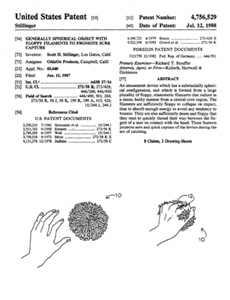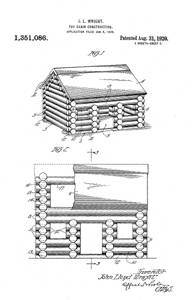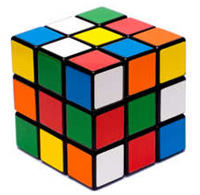Have you ever wondered about the invention of your favorite toys? Every toy, every product, started as an idea somewhere. But whose idea was that Koosh Ball? Who designed that Rubik’s Cube that still has many of us stumped and frustrated?
The Koosh Ball
 The Koosh Ball was developed in 1986 by Scott Stillinger. He was attempting to design a ball that would be easier for his 5-year old daughter and 8-year old son to hold and throw. The original prototype was made from rubber bands. Stillinger received US Patent 4,756,529 on July 12, 1988 for a generally spherical object with floppy filaments to promote sure capture.
The Koosh Ball was developed in 1986 by Scott Stillinger. He was attempting to design a ball that would be easier for his 5-year old daughter and 8-year old son to hold and throw. The original prototype was made from rubber bands. Stillinger received US Patent 4,756,529 on July 12, 1988 for a generally spherical object with floppy filaments to promote sure capture.
In order to market the product, Stillinger created OddzOn Products Inc with his brother-in-law who had been a marketing manager at Mattel. The product was one of the hottest toys to receive for Christmas in 1988. It is has been estimated that millions of the toy have been sold.
Lincoln Logs
 The inspiration behind Lincoln Logs is a surprising one. This popular building toy was not inspired by an American log cabin. Instead the idea for the toy came from the foundation of Tokyo’s Imperial Hotel. The toy was designed by John Lloyd Wright, son of architect Frank Lloyd Wright, who saw the hotel designed by his father while it was under construction. John Lloyd Wright received US Patent 1,351,086 on August 13, 1920 for a Toy-Cabin Construction.
The inspiration behind Lincoln Logs is a surprising one. This popular building toy was not inspired by an American log cabin. Instead the idea for the toy came from the foundation of Tokyo’s Imperial Hotel. The toy was designed by John Lloyd Wright, son of architect Frank Lloyd Wright, who saw the hotel designed by his father while it was under construction. John Lloyd Wright received US Patent 1,351,086 on August 13, 1920 for a Toy-Cabin Construction.
Lincoln Logs were originally all-wood notched miniature logs that could be assembled into a log cabin. The set came with directions on how to build Uncle Tom’s Cabin and President Lincoln’s log cabin. The original sets brought out in 1916 were a huge success. They received another boost in sales after WWII due to the educational nature of the toy. Building with these toys challenged children’s powers of concentration and eye-hand coordination. Lincoln Logs were one of the first toys to be advertised on TV. Commercials for the toy could be seen on TV beginning in 1953.
Rubik’s Cube
 Erno Rubik was not attempting to create a what seems impossible to solve possible when designing the Rubik’s cube in 1975. Rubik was an instructor of interior design and architecture at Academy of Applied Arts and Crafts when he created the cube. In his spare time, he built models. The actual purpose behind the cube was to create a design in which the blocks could move independently without the entire model falling apart. Rubik marked each side of his first prototype with different colors. When he began moving the pieces, he realized that he could not restore the pieces to their original place. The story goes that it took Rubik a month to solve his own puzzle. Rubik was granted Hungarian patent HU170062 for his “Magic Cube” in 1975.
Erno Rubik was not attempting to create a what seems impossible to solve possible when designing the Rubik’s cube in 1975. Rubik was an instructor of interior design and architecture at Academy of Applied Arts and Crafts when he created the cube. In his spare time, he built models. The actual purpose behind the cube was to create a design in which the blocks could move independently without the entire model falling apart. Rubik marked each side of his first prototype with different colors. When he began moving the pieces, he realized that he could not restore the pieces to their original place. The story goes that it took Rubik a month to solve his own puzzle. Rubik was granted Hungarian patent HU170062 for his “Magic Cube” in 1975.
The first batch of the product was sold in Budapest toy stores in 1977. In 1979, Rubik signed a deal with Ideal Toys to market the toy to the rest of the world. The Rubik’s Cube hit shelves in the United States and the rest of the world in 1980. The puzzle was an instant success and has sold by the millions attracting the attention of everyone from kids to mathematicians. The first Rubik’s Cube world championship was held in Budapest in 1983. The winner solved the puzzle in twenty-three seconds. The puzzle can still be found on toy stores everywhere to torment you with its almost impossible solution.
